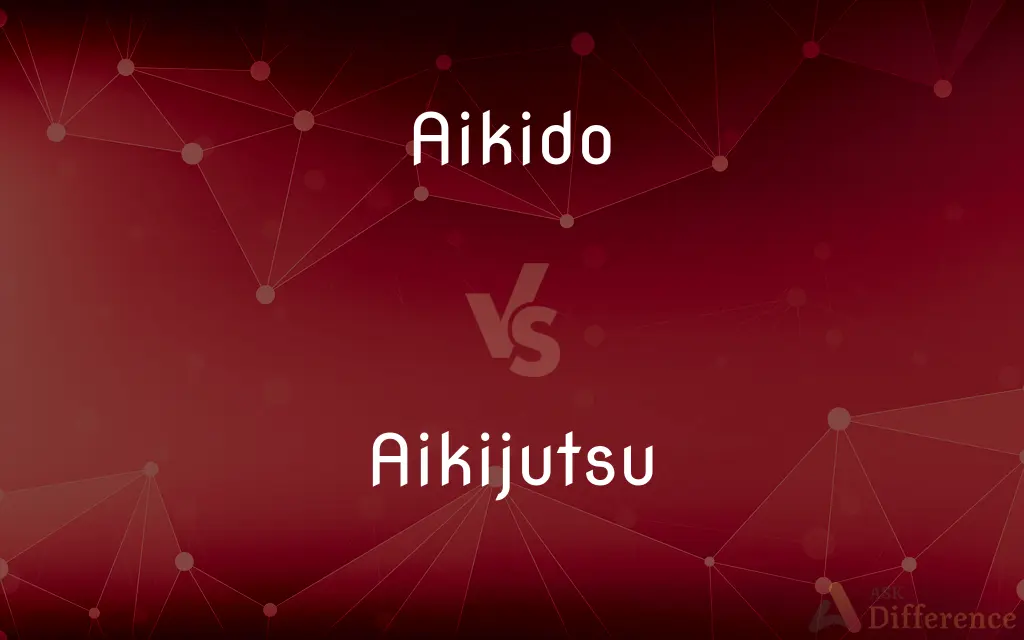Aikido vs. Aikijutsu — What's the Difference?
By Tayyaba Rehman — Published on January 18, 2024
Aikido is a modern Japanese martial art focusing on harmony and non-resistance, whereas Aikijutsu is a more ancient martial art emphasizing combat effectiveness and directness.

Difference Between Aikido and Aikijutsu
Table of Contents
ADVERTISEMENT
Key Differences
Aikido, developed in the early 20th century by Morihei Ueshiba, is a martial art that focuses on redirecting the attacker's energy and using joint locks and throws. Aikijutsu, dating back to the samurai era, is more combat-oriented, involving quick and effective techniques to neutralize opponents.
Aikido is known for its philosophy of harmony and non-resistance, aiming to resolve conflicts without harming the attacker. In contrast, Aikijutsu is more practical and direct, employing techniques that can be more damaging, reflecting its samurai battlefield origins.
Training in Aikido often includes learning to fall safely and practicing fluid, circular movements. Aikijutsu training tends to be more diverse, encompassing strikes, joint locks, and weapon techniques.
Aikido has a strong spiritual and philosophical component, focusing on self-improvement and peaceful resolution. Aikijutsu, while also emphasizing discipline and self-development, is more focused on practical self-defense and effectiveness in combat.
Aikido is generally more popular worldwide and practiced by those seeking a martial art with a peaceful approach. Aikijutsu, less widely known, attracts practitioners interested in traditional samurai techniques and effective self-defense strategies.
ADVERTISEMENT
Comparison Chart
Origin and Development
Developed in the early 20th century.
Dates back to the samurai era.
Philosophical Approach
Focuses on harmony, non-resistance, and peaceful conflict resolution.
More combat-oriented, emphasizing effectiveness and directness.
Techniques
Joint locks, throws, redirecting attacks.
Strikes, joint locks, weapon techniques, quick neutralization.
Training Focus
Fluid movements, falling safely, spiritual development.
Diverse combat skills, practical self-defense.
Global Presence
Widely practiced worldwide.
Less widely known, more traditional.
Compare with Definitions
Aikido
A martial art focusing on harmony and redirecting attacks.
In Aikido, we learn to harmonize with our opponent's movements.
Aikijutsu
Focuses on quick neutralization of opponents.
Aikijutsu emphasizes quickly controlling and neutralizing an attacker.
Aikido
Emphasizes joint locks and throws.
Aikido techniques often involve fluidly redirecting the opponent's force.
Aikijutsu
Includes diverse techniques like strikes and joint locks.
In Aikijutsu, we learn a variety of techniques including grappling and striking.
Aikido
Aims for peaceful conflict resolution.
Aikido teaches how to resolve conflicts without causing harm.
Aikijutsu
An ancient martial art focusing on combat effectiveness.
Aikijutsu techniques are direct and effective for self-defense.
Aikido
Known for its spiritual and philosophical aspects.
Aikido not only trains the body but also the mind and spirit.
Aikijutsu
Originated from samurai martial arts.
Aikijutsu has its roots in the combat practices of the samurai.
Aikido
Practiced globally as a form of self-improvement.
People worldwide practice Aikido for its benefits in self-development.
Aikijutsu
Less known globally, maintaining traditional aspects.
Aikijutsu remains a martial art deeply connected to its traditional roots.
Aikido
A Japanese art of self-defense that employs holds and locks and that uses the principles of nonresistance in order to debilitate the strength of the opponent.
Aikido
(uncountable) A Japanese martial art developed from jujitsu and making use of holds and throws.
Aikido
(countable) A school of the martial art.
Aikido
A Japanese martial art employing principles similar to judo
Common Curiosities
Does Aikido involve strikes?
Aikido primarily focuses on throws and joint locks, not strikes.
Who founded Aikido?
Morihei Ueshiba in the early 20th century.
Is Aikijutsu suitable for self-defense?
Yes, it's effective for practical self-defense.
What are the origins of Aikijutsu?
It originates from the martial practices of the samurai.
Is Aikido a spiritual practice?
Aikido has strong spiritual and philosophical elements.
What is Aikido?
A martial art focusing on harmony and non-resistance.
How is Aikido practiced worldwide?
It's widely practiced for its physical and spiritual benefits.
Are weapons used in Aikijutsu?
Yes, Aikijutsu includes training with traditional weapons.
Can Aikido be used in real-life self-defense?
While not its primary focus, Aikido can be applied in self-defense.
What is Aikijutsu?
An ancient martial art emphasizing effective combat techniques.
Is Aikijutsu still practiced traditionally?
Yes, it maintains many traditional aspects and techniques.
Are there competitions in Aikido?
Aikido generally does not focus on competitions or sparring.
What makes Aikijutsu different from other martial arts?
Its directness, effectiveness, and historical samurai roots.
How diverse are the techniques in Aikijutsu?
Aikijutsu encompasses a wide range of techniques, including strikes and grappling.
Can beginners start with Aikido or Aikijutsu?
Yes, both are suitable for beginners and offer progressive learning.
Share Your Discovery

Previous Comparison
Human Resource Management vs. Strategic Human Resource Management
Next Comparison
Gmail vs. OutlookAuthor Spotlight
Written by
Tayyaba RehmanTayyaba Rehman is a distinguished writer, currently serving as a primary contributor to askdifference.com. As a researcher in semantics and etymology, Tayyaba's passion for the complexity of languages and their distinctions has found a perfect home on the platform. Tayyaba delves into the intricacies of language, distinguishing between commonly confused words and phrases, thereby providing clarity for readers worldwide.













































